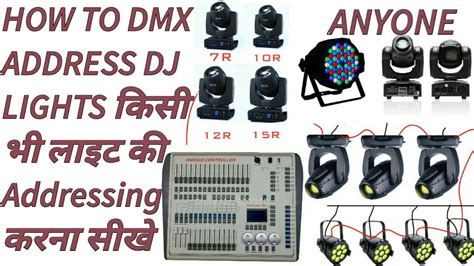DMX Addressing: Unlock the Power of Your Lights
DMX (Digital Multiplex) addressing is the crucial first step in controlling multiple lighting fixtures independently. Without proper addressing, your lighting system is just a collection of individual bulbs; with it, you unlock the potential for dynamic and sophisticated light shows. This comprehensive guide will explore the intricacies of DMX addressing, empowering you to harness the full potential of your lighting setup.
What is DMX Addressing?
DMX512 is a standardized communication protocol that allows a single controller to manage up to 512 channels of lighting information. Each channel corresponds to a specific function of a lighting fixture, such as color, intensity, or gobo pattern. DMX addressing assigns a unique numerical address to each fixture, allowing the controller to pinpoint which light receives which instruction. Think of it like assigning individual house numbers to homes on a street; each house receives a specific delivery (light command) because of its unique address.
Why is DMX Addressing Important?
Proper DMX addressing is paramount for several reasons:
- Independent Control: Each fixture with its own address can be controlled separately. This allows for complex lighting designs with individual lights reacting dynamically to music, cues, or other triggers.
- Precise Lighting Design: Precise control over individual fixtures allows for nuanced lighting effects, creating the perfect ambiance for any event.
- Efficient Workflow: With correct addressing, setup and troubleshooting become significantly easier. You can quickly identify and address problems with specific fixtures.
- Scalability: DMX is scalable, allowing you to expand your lighting setup by simply adding more addressed fixtures.
How to Address DMX Fixtures
The process of DMX addressing varies slightly depending on the fixture and controller, but generally follows these steps:
-
Identify the Fixture's Addressing Method: Check your fixture's manual. Some fixtures use physical DIP switches, while others might have digital interfaces for setting addresses.
-
Set the Address: Using the designated method (DIP switches, software interface, etc.), assign a unique address to each fixture. Addresses typically range from 1 to 512. Crucially, avoid duplicate addresses!
-
Connect the Fixtures: Connect your fixtures to the DMX controller using DMX cables. Ensure all connections are secure.
-
Test Your Addressing: Use your DMX controller to send test signals to each fixture. Observe the responses to verify that each fixture is receiving the correct instructions at its assigned address.
Troubleshooting Common DMX Addressing Problems
-
No Lights Responding: Check all cable connections, verify power to the fixtures, and double-check the addresses for duplicates or errors.
-
Lights Responding Incorrectly: Verify the assigned addresses again, and confirm that the DMX controller is correctly configured for the number of channels used by each fixture.
-
Intermittent Signal: Damaged cables or poor connections are common culprits. Carefully inspect all cables and connectors.
What are the different types of DMX controllers?
There's a wide range of DMX controllers available, each catering to different needs and budgets. They range from simple, handheld units ideal for smaller setups to sophisticated software-based controllers capable of managing complex light shows with hundreds of fixtures. The choice depends largely on the scale and complexity of your lighting project.
Choosing the Right DMX Controller: What to consider?
Consider the following when selecting a DMX controller:
-
Number of channels: This should correspond to the total number of control channels required by your lighting fixtures.
-
Software capabilities: Software-based controllers offer features such as sequencing, cueing, and visual programming.
-
Connectivity options: Check for compatibility with your lighting fixtures and other equipment.
-
User-friendliness: The interface should be intuitive and easy to use, particularly for beginners.
-
Budget: Prices vary considerably depending on features and capabilities.
What is a DMX Splitter?
A DMX splitter allows you to send a single DMX signal to multiple universes (512 channels per universe). This is necessary when controlling more than 512 channels of lighting fixtures. Splitters ensure the signal remains strong and reliable across all connected devices.
How many DMX universes can I use?
The number of DMX universes you can use depends on your controller's capabilities and the complexity of your lighting setup. Some advanced controllers can handle multiple universes simultaneously.
By understanding and implementing DMX addressing, you take a pivotal step towards realizing the creative potential of your lighting system. With careful planning and attention to detail, you can achieve impressive results and elevate your lighting projects to the next level. Remember to always consult your equipment's manual for specific instructions and safety precautions.

